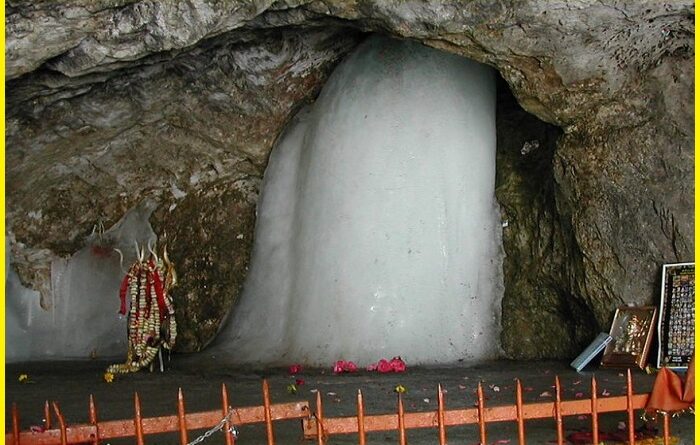Amarnath Temple-A Pilgrimage to the Heart of the Himalayas
Amarnath Temple
Amarnath Temple is a Hindu temple located in the Anantnag district of Jammu and Kashmir, India. It is dedicated to Lord Shiva and is one of the most sacred shrines in Hinduism. The temple is situated at an altitude of around 3,888 meters above sea level and is surrounded by snow-capped mountains and pristine natural beauty. The Amarnath temple is located in a cave and is accessible only during the summer months, as it remains covered in snow for the rest of the year.
Amarnath Temple is believed to have been discovered by a shepherd who saw a stream of milk flowing from a rock. Upon investigation, he discovered the ice lingam, which is believed to be a form of Lord Shiva. Since then, the cave has been considered a sacred site for Hindu devotees.
The Amarnath Yatra, which is a pilgrimage to the temple, takes place every year during July and August. The Yatra involves a strenuous trek of around 45 kilometers from the town of Pahalgam or around 14 kilometers from Baltal, through treacherous mountainous terrain. The temple is accessible only by foot, and the journey is considered challenging and dangerous, requiring physical fitness, stamina, and adequate preparation.
Despite the challenges, the yatra attracts a large number of devotees from all over India and is considered a deeply spiritual and fulfilling experience. The Amarnath Temple is a significant pilgrimage site for Hindus and is a symbol of the deep devotion and faith of the people. It is an essential part of India’s rich cultural heritage and spiritual legacy.

Amarnath Temple History
The history of Amarnath Temple dates back to ancient times and is shrouded in myths and legends. According to Hindu mythology, the cave where the temple is located was discovered by Bhrigu Muni, a Hindu sage who was searching for Lord Shiva.
Legend has it that Lord Shiva revealed the secret of immortality to Goddess Parvati in the cave, and it was here that he also left behind his Trishul or trident. Another legend states that Lord Shiva decided to take refuge in the cave to escape the attention of his devotees and meditated here in isolation for thousands of years.
The discovery of the cave in modern times is attributed to a Muslim shepherd named Buta Malik, who was guided by a saint to the cave in the 15th century. The story goes that Buta Malik was offered a bag of coal by the saint, which turned out to be a bag of gold when he opened it. The saint then revealed the cave to him and told him about the lingam inside.
Also read- Pahalgam Kashmir-The Place Makes the Amarnath Yatra in Reality
Since then, the cave has been an important pilgrimage site for Hindus, and the Amarnath Yatra began in the 19th century. The yatra was popularized by a Kashmiri Pandit named Buta Kaul, who began organizing the pilgrimage and set up facilities for the devotees.

Over the years, the Amarnath Yatra has grown in popularity and has become a significant event in the Hindu calendar. The cave and the lingam are considered to be manifestations of Lord Shiva and are believed to have healing powers. The yatra attracts thousands of devotees every year, who brave the challenging terrain to seek the blessings of Lord Shiva.
Amarnath Lingham
Lord Shiva is an extremely popular Hindu deity, not only among Indians but also among people of other nationalities. Shiva lingam appears in the Amarnath cave in the unique form of an Ice Lingam, millions of devotees trek through the daunting mountains to Shri Amarnathji Shrine in South Kashmir every year in the summer months to pay obeisance.
The ice pillar present inside the cave is also called ice lingam, the phallic symbol of Lord Shiva. Two smaller ice stalagmites represent Parvati, his wife, and Ganesha, his son. The Hindu pilgrims also believe that the height of the lingham increases and decreases with the phases of the moon. In the month of Shravan, on the full moon in August, thousands of Hindus go on a pilgrimage up to the cave. At this time the lingam reaches its biggest size.
The Amarnath Cave
The cave is quite large. Its entrance is about 37 meters horizontally and in height it is about 22 meters and is sloping 24 meters deep down inside the mountain. In the cave is an ice-lingam of about 15 meters high and at the top, it forms a cone. This symbolizes Lord Shiva and to the left of the lingam is a small ice block which stands for Lord Ganesha and to the left of the latter is a small ice formation representing goddess Parvati. These ice formations are formed during, the summer days and wax and wane along with the moon. On the full moon day, they are complete in form whereas on moonless days they altogether vanish.

Amarnath temple tour packages
To visit the Amarnath temple, you need to undertake a trek of approximately 42 kilometers from the base camp at Baltal or Pahalgam. The pilgrimage season usually starts in late June and ends in August. To find suitable tour packages for Amarnath temple, you can search online on travel websites or consult with a local travel agent. You can also contact the Jammu and Kashmir Tourism Department or the Shrine Board of the temple for more information about the pilgrimage and tour packages. Make sure to compare prices, services, and reviews of different tour operators before finalizing a package.
If you’re planning to visit the Amarnath Temple, It’s advisable to book your tour package well in advance to avoid any last-minute hassles. The temperature at Amarnath Temple can drop below freezing point, even during the summer months, so make sure to carry warm clothes and blankets. The high altitude and low oxygen levels can cause altitude sickness, so it’s important to acclimatize yourself before starting the trek.

How to reach Amarnath Mandir
The nearest airport to Amarnath Temple is the Srinagar International Airport. From the airport, you can take a taxi or a bus to reach Pahalgam, which is the base camp for the Amarnath Yatra. The nearest railway station to Pahalgam is Jammu railway station. Pahalgam is well-connected by road to major cities like Srinagar, Jammu, and Delhi. The final leg of the journey to the Amarnath Temple involves a 42-km trek from Pahalgam. You can hire a pony or a palanquin to carry your luggage ride on a pony or walk the entire distance.
Pahalgam to Amarnath temple distance
The distance from Pahalgam to Amarnath Mandir is approximately 46 kilometers. The journey involves a 14 km trek from Pahalgam to Chandanwari, followed by a 30 km trek from Chandanwari to the Holy Cave of Amarnath. The final 2 km of the journey to the cave is a steep climb, which can be challenging for some visitors. It is important to be physically fit and mentally prepared for the journey and to take adequate precautions to ensure safety and comfort during the trek.



